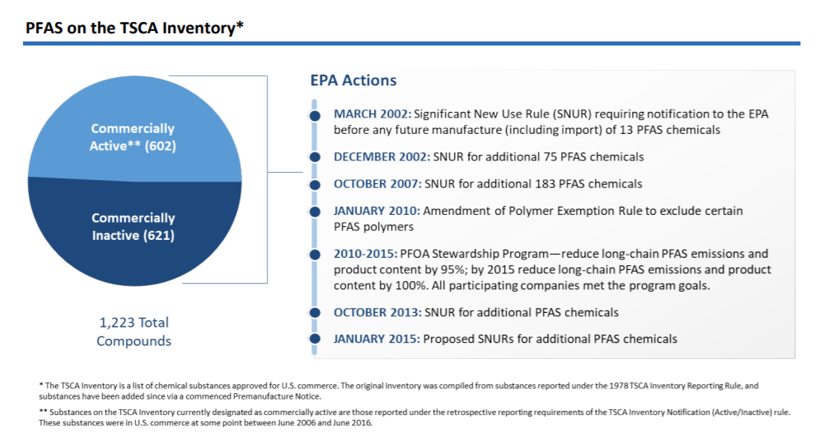NOTE: This article was originally posted on September 24, 2019.
Emerging contaminants, an increasingly focused-on topic in the field of environmental science, refers to previously unknown and unregulated chemicals with unique physical properties that affect detection and cleanup, and that are actively being studied. Since the 1990s, there have been a growing number of studies that are looking at a wide range of chemical compounds and what effects they have on our waterways and by extension, on us. While a chemical like 1,4-dioxane is useful as an industrial solvent and PFAS provide us luxuries like being able to make perfect sunny-side up eggs every single time, they don’t break down and tend to stick around for a long time in various matrices. Bioaccumulation up the food chain is a serious concern when considering the effects of emerging contaminants in our lakes and rivers and the aquatic species that end up on our dinner plates. Chemicals like the ones listed above are highly soluble and mobile in groundwater, and in-situ remedies for compounds like PFAS haven’t yet been proven to be either technically practical or cost-effective.
The U.S. Environmental Protection Agency
(USEPA) has to make decisions on what chemicals and compounds to study based on yearly funding, so even though it has an action plan for the challenges surrounding PFAS, the establishment of federal standards and guidelines for emerging contaminants will be slow. Individual states and some countries are introducing standards around groundwater and drinking water for PFAS. Several subnational governments and even a few countries have developed soil standards for select PFAS. However, a general lack of federal policy and regulatory guidance regarding many of these chemicals will continue to exist for some time in the United States.
We received a number of questions regarding emerging contaminants during our recent webinar, Lurking Beneath the Surface: Could Emerging Contaminants Affect Your Next Deal? and we’ve addressed them below:
Why are PFAS compounds routinely measured at single digit ppt concentrations when lab data quality for every other compound is questionable at fractional ppb levels?
The need for a detection limit in the part per trillion (ppt) range is due partly to the current levels set by the USEPA’s 2016 Lifetime Health Advisory for PFOA and for PFOS, which sets the individual PFOA and PFOS health advisory levels at 70 ppt when present in drinking water (or at a combined concentration of 70 ppt if both PFOA and PFOS are present). Several states already have much lower standards than USEPA’s health advisory levels and apart from just PFOA and PFOS. USEPA developed these health advisories based on peer-reviewed studies of the effects of PFOA and PFOS on laboratory animals, as well as information from epidemiological studies of human populations that have been exposed to PFAS. The health advisories were calculated to protect the most sensitive populations, namely fetuses during pregnancy and breastfed infants.
Because of the need to achieve low detection limits to quantitatively identify PFAS, approved laboratory methods for detection are scarce. USEPA Method 537 Version 1.1 and Method 537.1 exist, although both only apply to drinking water. An approved standard to test for PFOA and PFOS at very low levels was necessary for public water supplies (PWSs) to meet the requirements of the Unregulated Contaminated Monitory Rule #3 (UCMR3), which included requirements for certain PWSs to test finished drinking water for PFOA and PFOS.
As you note in your question, achieving accurate results at such low detection limits is difficult, and the regulatory and analytical communities have been hard at work identifying solutions.
Given the 537 Version 1.1 and 537.1 methods are intended for water with low total suspended and dissolved solids, using them on groundwater samples can present challenges because these samples are often turbid or have high total dissolved solids, which can interfere with the accuracy of the approved methods. As such, USEPA has validated and published proposed standards (Method 8327) for 24 specific PFAS in groundwater, surface water, and wastewater; however, this method may not be sufficient for low‐level detection or rigorous reporting quality. USEPA is currently developing methods for analysis of other media such as soils and biosolids (Method 8328); shorter-chain PFAS (Method 533); and for air samples; the total oxidizable precursor (TOP) assay, and a total organic fluorine (TOF) method.
Until these methods can be validated and finalized, we recommend working with your laboratory to discuss which methodologies they will use for your media of concern and how they will validate the data generated.
Are there testing distinctions between drinking water and industrial/wastewater?
As we noted above, the only approved methodology for PFAS sampling is for finished drinking water samples and, even then, only for certain PFAS. USEPA’s February 2019 Action Plan for PFAS notes that USEPA is taking a multi-faceted regulatory approach to regulating PFAS. While the current focus under the UCMR3 has been on drinking water supplies and the Safe Drinking Water Act (SDWA), USEPA is planning to evaluate development of ambient water quality criteria under section 304(a) of the Clean Water Act (CWA). USEPA also plans to begin studies of the potential for PFAS to be present in wastewater discharges from certain point source categories, including manufacturers of organic chemicals, plastics, synthetic fibers, textiles, and pulp and paper, as well as discharges from airports and Publicly Owned Treatment Works (POTWs). As we noted in the webinar, a number of states are moving forward more aggressively on these fronts and requiring PFAS to be considered in applications for industrial wastewater permits.
We are finding more and more that developing regulations and customers are looking to eliminate perfluorinated compounds without specific CAS numbers. Our scientists pointed out during the seminar that this could mean hundreds of compounds. How are you addressing this?
The increased public awareness around PFAS is creating pressure to regulate PFAS as a class rather than regulate each PFAS individually. USEPA is aware of this and is working to increase public awareness around this topic. For example, USEPA and others coined the term “PFAS” to distinguish these compounds from perfluorocarbons, which have made for good media coverage as they relate to global climate change.
In the February 2019 Action Plan, USEPA outlines proposed actions to regulate its other perfluorinated compounds to help regulators and members of industry speak the same language. In addition to the various regulations regarding potential contamination to drinking water and wastewater, USEPA is working to regulate the manufacture of PFAS through the Toxic Release Inventory (TRI) and Toxic Substances Control Act (TSCA) regulations. For example, one of the short-term goals of USEPA is to establish and curate a clearinghouse of chemical information for PFAS using the CompTox Chemistry Dashboard, and to use the Frank R. Lautenberg Chemical Safety for the 21st Century Act to review new PFAS and issue supplemental proposed Significant New Use Rules (SNURs) for PFAS. You can see in the graphic below how USEPA has been using SNURs and TSCA to regulate specific PFAS.

Congress and the Senate have each introduced bills intended to designate PFAS as a hazardous substance under the Comprehensive Environmental Response, Compensation and Liability Act (CERCLA), which could have far-reaching implications if passed. It is highly likely such a designation would result in significant litigation, and which could take a while to ferret itself out. A recent PFAS Experts Symposium held in Washington, D.C. in May of this year goes into greater detail on this.
We’ve been advising clients to keep abreast of the issue and to actively participate in the public comment periods for any upcoming regulations. Various manufacturing associations, such as the American Chemistry Council, are also actively involved in the process and can provide additional help.
PFAS are clearly a risk for land owners, but what are the concerns for a contractor going to a third party’s site to do work? Unknown on-site risks, material brought to a site, contracting operations, all come to mind, but what should their concerns be regarding PFAS?
Contractors working on sites where PFAS may be a contaminant need to be aware not only of risks their employees could face during work on-site, but also risks in which they could possibly affect the results of sampling investigations, remedial projects, etc.
Contractors performing sample collection activities are advised to review the Interstate Technology and Regulatory Council’s (ITRC’s) guidance on minimizing or eliminating the use of certain commercial products that may contain PFAS, including such common items as certain sunscreens, adhesive notes, waterproof field books, waterproof clothing, Tyvek and aluminum foil. Practitioners also need to be careful to avoid cross-contamination of samples; field quality control (QC) samples are particularly important when sampling for PFAS to ensure proper validation of any data set.
Limited guidance is currently available on minimizing construction worker exposure to sites where PFAS contamination may be present. However, it’s important to note that the primary exposure pathways to PFAS are through ingestion, either by drinking contaminated water or consuming fish or other foods where one or more PFAS have bio-accumulated. Although inhalation has been noted as a potential exposure pathway, this is predominantly an issue at facilities that manufacture PFAS. If you will be working at a site where PFAS are a concern, we recommend reviewing potential exposure pathways as part of routine health and safety planning. Health and Safety Plans (HASPs) should include provisions for keeping employees safe from all hazards, not just those related to PFAS (e.g., when considering precautions related to waterproof clothing, consider ways to cover waterproof steel-toed boots rather than forgoing the boots!).
FOR MORE INFORMATION
A replay of the webinar will answer the following questions, among others:
- What are emerging contaminants and how reliable is the available information on the internet?
- How are federal and state regulators addressing emerging contaminants?
- What are some examples of how emerging contaminants affected a potential real estate transaction and how these issues were managed?
- What can I as an investor do to protect myself during a transaction?
Here’s what attendees had to say about the presentation:
“Great succinct summary. I enjoyed the clarity of the presentation. Although I have been in the business for decades … I learned something new today for my 'bag of tricks'!”
“Nice, focused presentation.”




